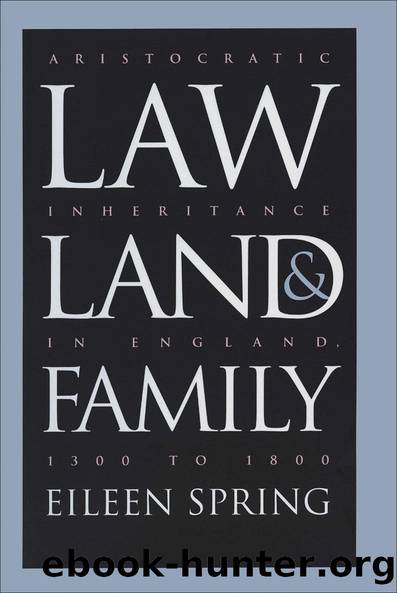Law, Land, and Family by Eileen Spring

Author:Eileen Spring [Spring, Eileen]
Language: eng
Format: epub
Tags: History, Europe, Great Britain, General, Law, Legal History
ISBN: 9780807864708
Google: _oZhCQAAQBAJ
Publisher: Univ of North Carolina Press
Published: 2000-11-09T02:56:48+00:00
2
The histories of the heiress and the widow, of course, do not make up the whole of the aristocratic familyâs history. Younger children are not to be ignored in discussing the overall pattern. But while the heiress and the widow fell spectacularly from a high when the common law prevailed to a low in the eighteenth century, no spectacular movement marked the history of younger children. Their portions fluctuated from time to time, but within a range that was limited compared to other movements of family property. It was not on younger children that landowners had their eyes fixed as they developed inheritance stratagems. But even the interests of younger children declined in the eighteenth century, those of younger sons especially. Younger sons seem to have done rather well in medieval times. No doubt one of the reasons why they could be cut off with less in the eighteenth century lay in the increased employment opportunities that came their way with the growth of the professions and the rise of the administrative state.
When developments are considered over the whole family and over the long run, the pattern evident may be summed up somewhat as follows: What landowners wanted, or had come to want, was some means of husbanding resources in the hands of the male head of the family, while not utterly disinheriting the familyâs subordinate members. Under the principles of English law what they wanted was not easily to be obtained. They had had first to dispose of rules that provided for female inheritance far more generously than they thought proper, and for younger children less generously. Having gained freedom of alienation, they lacked any positive restraining device, which only at length was the strict settlement to confer upon them.
When seen thus, which is to say when seen in the light of the family, landownersâ history takes on a coherenceâone might even say a simplicityâthat it does not otherwise have. The progression that is to be traced in their history from the common law to wills (that is, to testamentary dispositions through uses) and then from wills to the strict settlement appears on the surface to be an incoherent journey, being a journey first towards and then away from freedom of alienation. Looked at against the common law rules, it becomes entirely coherent, the natural working out of aristocratic ideas of heirship against those embodied in the common law. In current terminology, what has seemed discontinuity in landownersâ actions becomes in a fundamental way continuity.
This view of landownersâ history, as has already been suggested, differs from the one traditional in doctrinal histories. The traditional view sees real property law as reflecting a long struggle between landowners determined on perpetuities and the common law judges determined on freedom of alienation. The two views fundamentally agree in that they recognize a movement towards freedom of alienation with uses and then away from it with the strict settlement. Moreover, it is true that many common law judges, Coke in particular, were adamant against perpetuities.
Download
This site does not store any files on its server. We only index and link to content provided by other sites. Please contact the content providers to delete copyright contents if any and email us, we'll remove relevant links or contents immediately.
The Social Psychology of Inequality by Unknown(2313)
The Plant Paradox by Dr. Steven R. Gundry M.D(2047)
The Writing on the Wall by Anselm Jappe(1761)
Working for Yourself by J.D. (Nolo) Stephen Fishman(1480)
Every Landlord's Legal Guide by Janet Portman & Stewart Marcia & Ralph Warner(1329)
The First 20 Hours: How to Learn Anything ... Fast by Kaufman Josh(1308)
ADHD on Trial by Michael Gordon(1242)
Decisive by Chip Heath(1202)
Drafting Contracts: How and Why Lawyers Do What They Do, Second Edition by Stark Tina L(1174)
Working for Yourself by Stephen Fishman J.D. (Nolo)(1141)
The Economist Aug 8th 2015 by The Economist(1124)
Restitution by Restitution(1116)
The Economist Aug 29th 2015 by The Economist(1099)
A Practical Guide to International Arbitration in London by Hilary Heilbron(1085)
The Lord of the Rings: The Fellowship of the Ring, the Two Towers, the Return of the King by J. R. R. Tolkien(1084)
Intellectual Property Strategy by John Palfrey(1083)
Collusion by Luke Harding(1046)
Persuasion by Owner(1017)
Chapter 1 by Owner(952)
